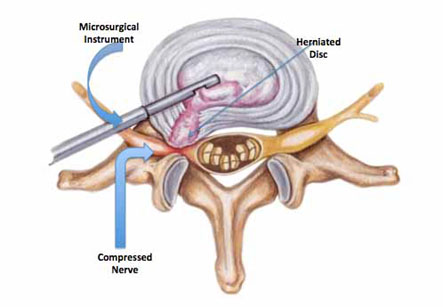Endoscopic Discectomy
Introduction
Herniated discs are often referred to as “slipped discs”. This term is derived from the action of the nucleus tissue when it is forced away from the center of the disc. There is no actual slipping of the disc itself. The nucleus tissues located in the center of the disc are sometimes placed under so much pressure that it can cause the annulus to herniate or rupture against one or more of the spinal nerves. This causes pain, numbness, or weakness in the low back, leg or foot. Herniated discs are also referred as “prolapsed”, “bulging”, or “ruptured disks.
Prototype of the microendoscopic discectomy is a lumbar disk surgery, as the lumbar spine is commonly involved in slipped disk. This is a minimally-invasive surgical procedure designed to remove portions of a herniated disc that pinch upon the nearby nerves. The surgeon performs the procedure with the help of images from a thin, small camera called as an endoscope.
Endoscopic discectomy is specifically recommended for patients with disc problems associated with the following:
1. Recurring pain in the buttocks, groin, low back, or leg, numbness or weakness
2. Pain or other symptoms that do not respond to conservative treatments such as bed rest, pain medications, physical therapy, or muscle relaxants
3. Disk herniation confirmed by CT Scan, MRI Scan, Myelography, or Discography.
We have all the information you need about public and private clinics and hospitals that provide spinal surgery in Iran, Islamic Republic Of with the best quality and lowest possible prices

Contraindications for this procedure are:
1. Evidence of neurological or vascular pathologies which can mimic a herniated disc
2. Advanced spondylosis with significant bony spurs
3. Advanced arthritis
4. Stenosis of spinal canal caused by bone only.
Choice of surgeon:
Typically, if an orthopedic surgeon is performing a substantial spine operation, a neurosurgeon is present as well. If a neurosurgeon is doing an operation that extensively involves bone, joint or the possibility of fusion, then an orthopedic surgeon is involved as well.
Procedure:
As the micro-endoscopic surgery is a minimally-invasive procedure, it reduces damage to the bone and soft tissue associated with more traditional open disc surgery.
1. At the beginning of the procedure, the surgeon makes a small cut or incision slightly to one side of the center of the back. The muscle tissues are then gradually separated until a small hole is created that directly exposes the bone in the spinal column.
2. The surgeon then inserts the endoscope into this hole and performs the rest of the surgery under the guidance of a video monitor that displays live, enlarged images from the camera.
3. After this, the surgeon uses a specialized drill to make a small hole in the spinal bone and accesses the herniated disc and its neighboring nerves. The damaged portions of the disc are removed, along with any disc material that is pressing on the nerves.
4. After completing these tasks, the endoscope is removed and the hole in the back is closed with a couple of stitches. The hole in the spinal bone heals on its own over time.
Indications:
1. Surgery is usually performed to decrease pain and also to regain normal movement and function.
2. Pain in the leg, numbness, or weakness which can make the patient unable to perform the daily activities.
3. The leg symptoms which do not get better after at least 4 weeks of conservative treatment.
4. Weakness of legs or loss of motion found on physical examination which is likely to get better after surgery.
5. Surgery is considered as an emergency option in case of cauda equina syndrome. Signs of this syndrome include:
• Recent loss of bowel or bladder control.
• Recent onset of weakness in the legs (usually both legs).
• New numbness or tingling in the buttocks, genital area, or legs.
Benefits of endoscopic Discectomy:
1. Minimal damage to bone and muscle tissue, which means there is less surgical trauma than patients undergoing conventional open procedures.
2. Reduced recovery time and a quicker return to normal activities. Usually, the patient is encouraged to stand and start moving around on or shortly after the day of the procedure.
3. Endoscopic discectomy results in a lower rate of serious complications during or after surgery.
Risks:
As with any surgery, there are some risks. These include:
1. Failure of the purpose of surgery or no more benefit than other type of treatments. This can occur due to permanent damage to the nerve caused by slipped disk.
2. Slight risk of damaging the spine or nerves.
3. Infection
4. Risks of anesthesia.
5. Uncontrolled bleeding
6. Blood clot disorder known as deep vein thrombosis.